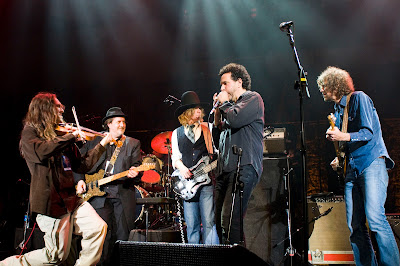I tend to be an autodiadactic learner, that is a style of learning where one teaches oneself. Backpacking, guitar and bass playing, auto repair, computers, sailing, flying (ok well maybe not flying). I can learn anything from a book. I often find someone or several peers to show me what they know and I ask questions.
I bought my first digital single lens reflex (DSLR) camera in 2003 to take on my honeymoon that year. I'd had a film SLR before was too frustrated by having to allow others to develop and print my images. My first was a Fuji S2 and added all Sigma lens (24-70mm) and (70-200). After I wore that one out, I moved to a Nikon D200 and then to my present D300. My lend collection is down to two Nikon fixed focus (50mm and 85mm) and three telephotos, Tokina (11-18mm), Sigma (24-70mm), and a Nikon (70-200) with Image Stabilization.
I started seriously shooting musical shows and processing in Photoshop. Each image I would open started with me trying to see what I'd done wrong and what would have been better. I maybe have activated a shutter over 50,000 time by now and have posted over 10,000 photos on my Smugmug site. Looking over some of the older ones today, I can see the progress made. Teaching myself may be inefficient but suits the way I like to learn. I also spend a great deal of time reviewing the work of others. I want to develop my own style.
Many things go into creating a great image. In performance photography, the subjects are not posing and concert photography, the light is changing constantly, rapidly, and drastically. The first thing I do to set up the camera for low light, even though it may seem like the stage is well lit, the colored lights do not reflect as white light does. ISO (what used to be film speed, when there was film) which now is the sensitivity of the sensor. Because it needs to be highly sensitive to the ambient light available, noise is likely to be introduced. The Nikon D300 can adjust the ISO on the fly within the parameters set.
I use manual setting to adjust the aperture, and shutter speed. Early in the show I am testing and monitoring the shoots on the camera display.
Next is camera angle, framing, position and avoiding gear on the stage. As I do not want every picture to look the same, I move around as much as possible. Up front, move back, find balconies and even climb onto the stage for shots. Lastly is catching that moment. The expressions on the faces, the looks between musicians, anything that conveys the feeling of the music. I also watch for faces in the crowd that express the music from the other side. I think that catching those magical expressions it what makes a great performance photograph.
I'll soon follow with more on creating HDR images.

No comments:
Post a Comment